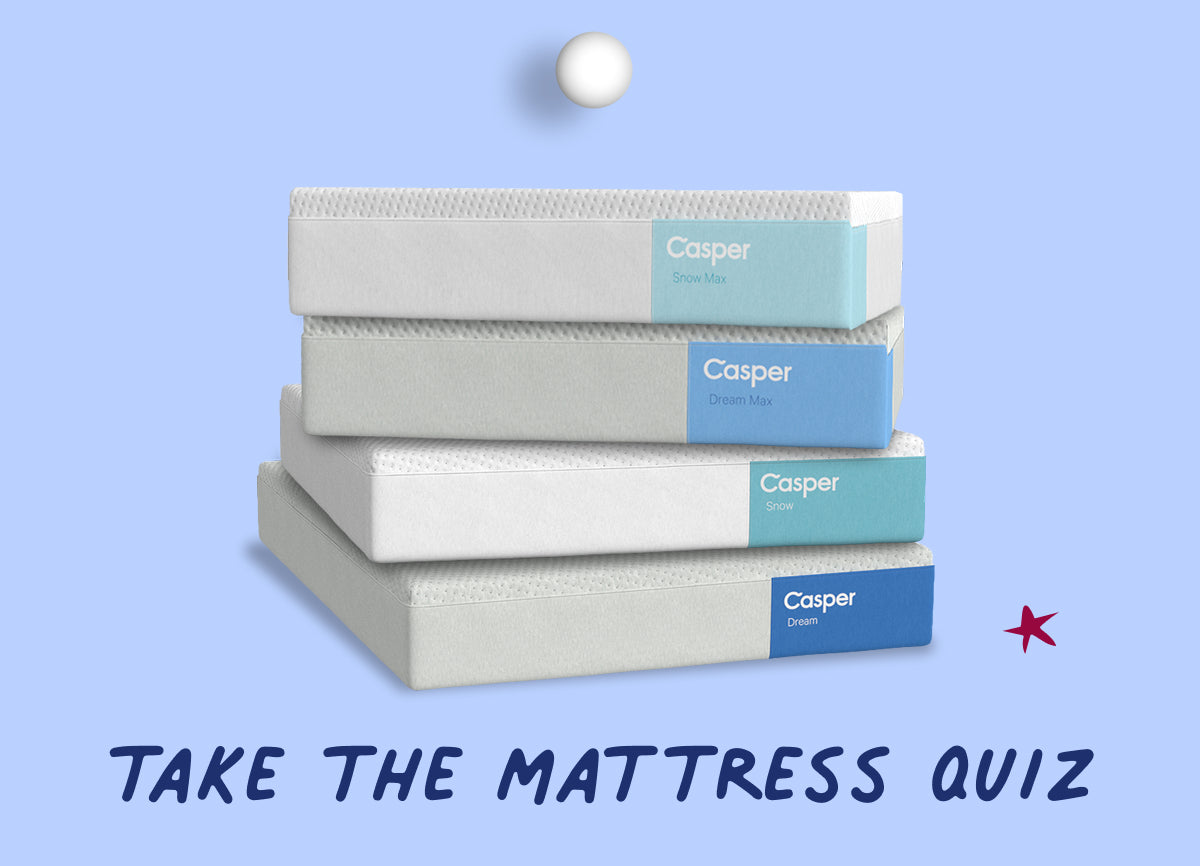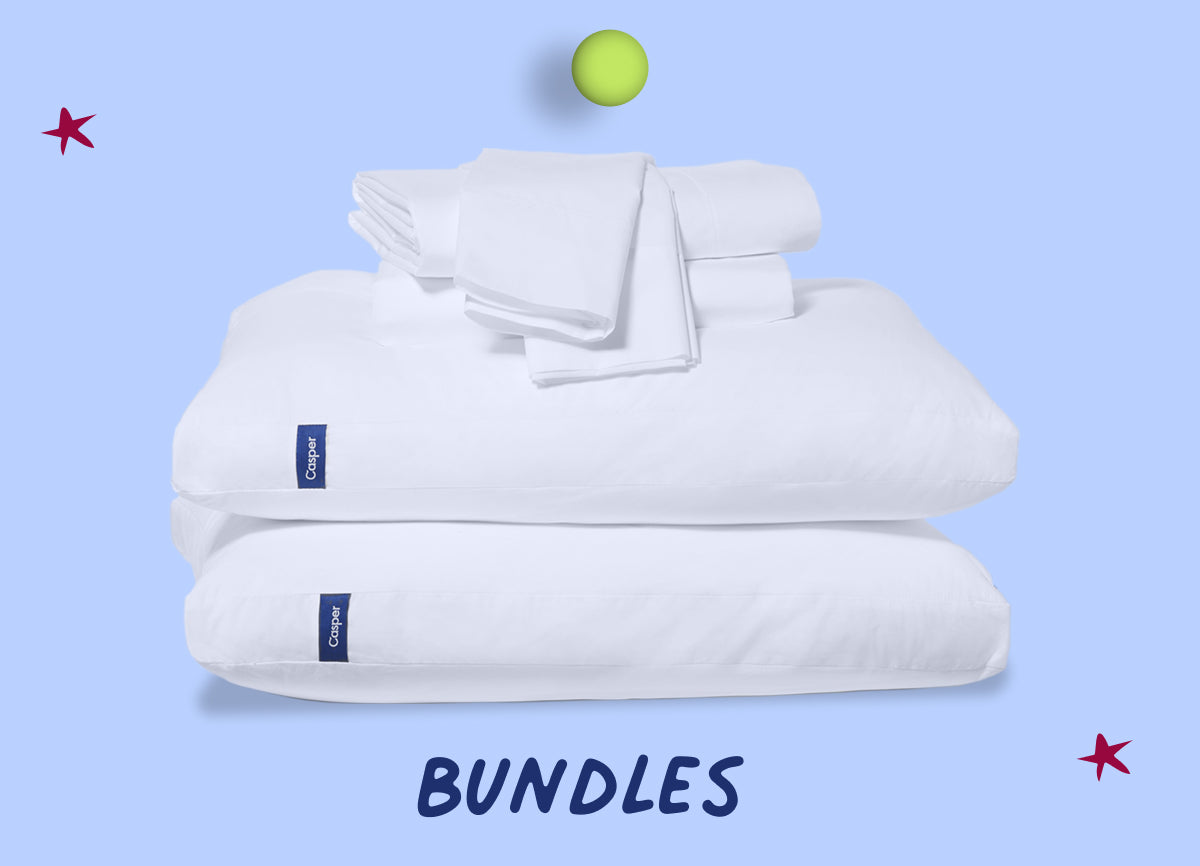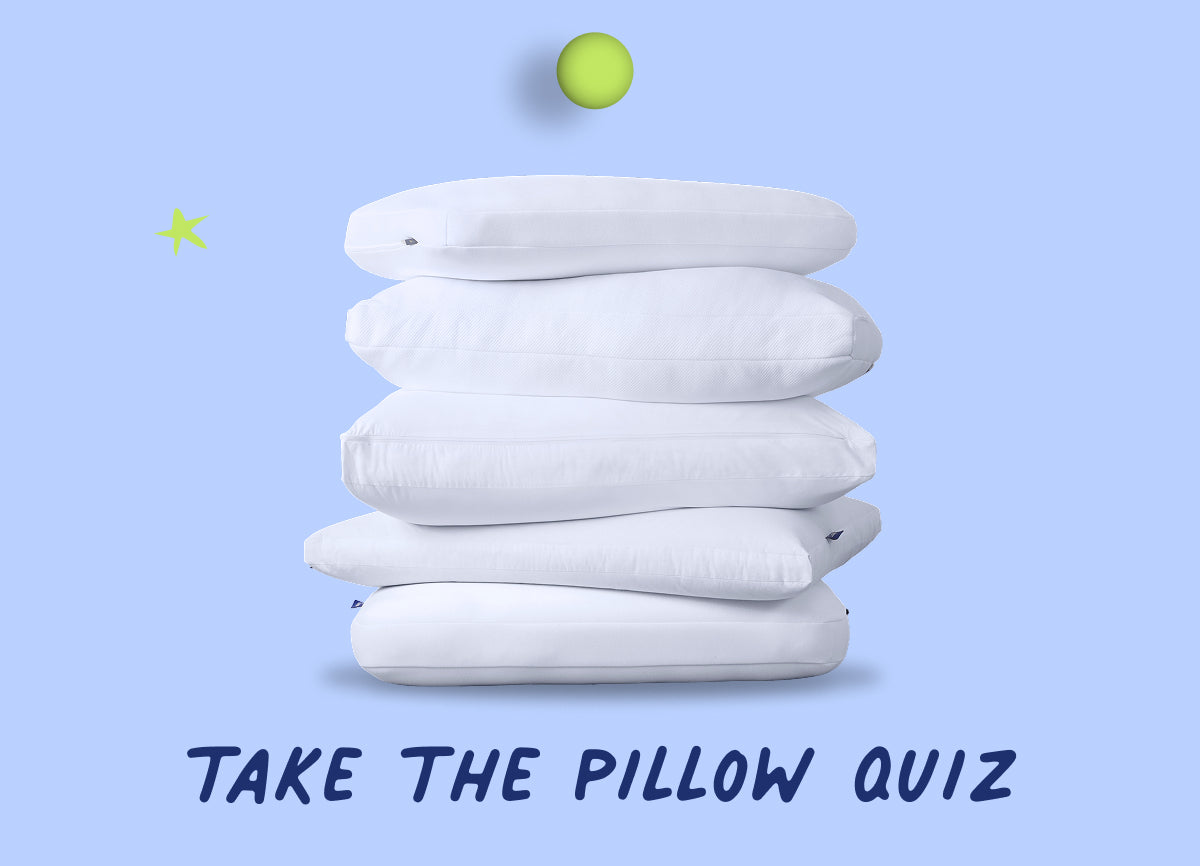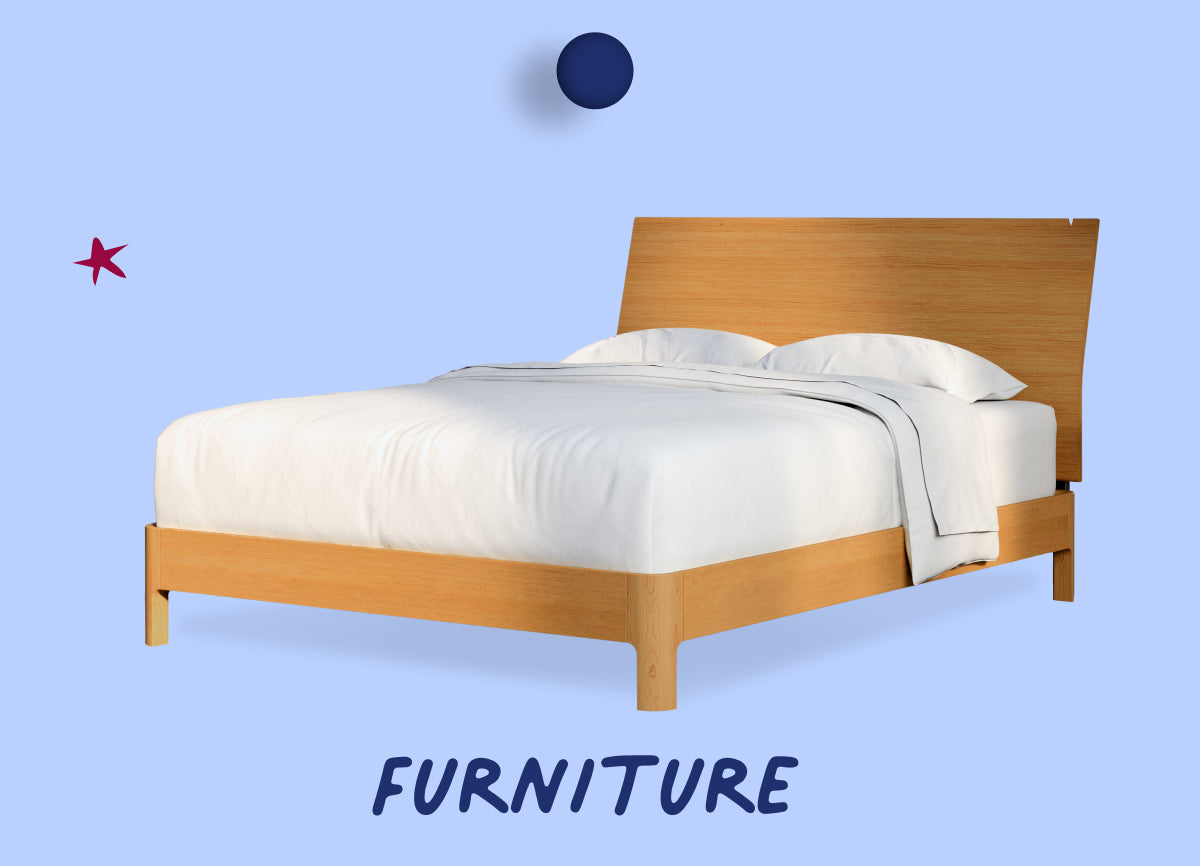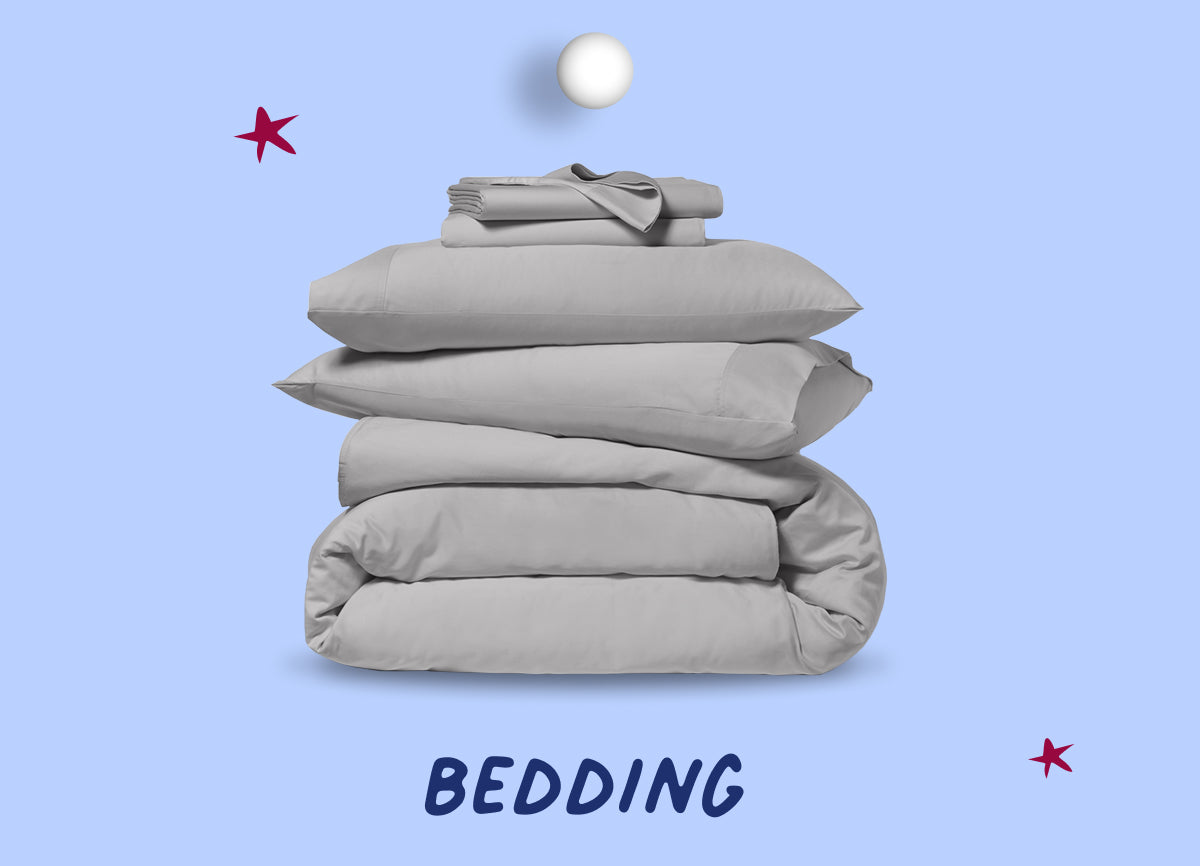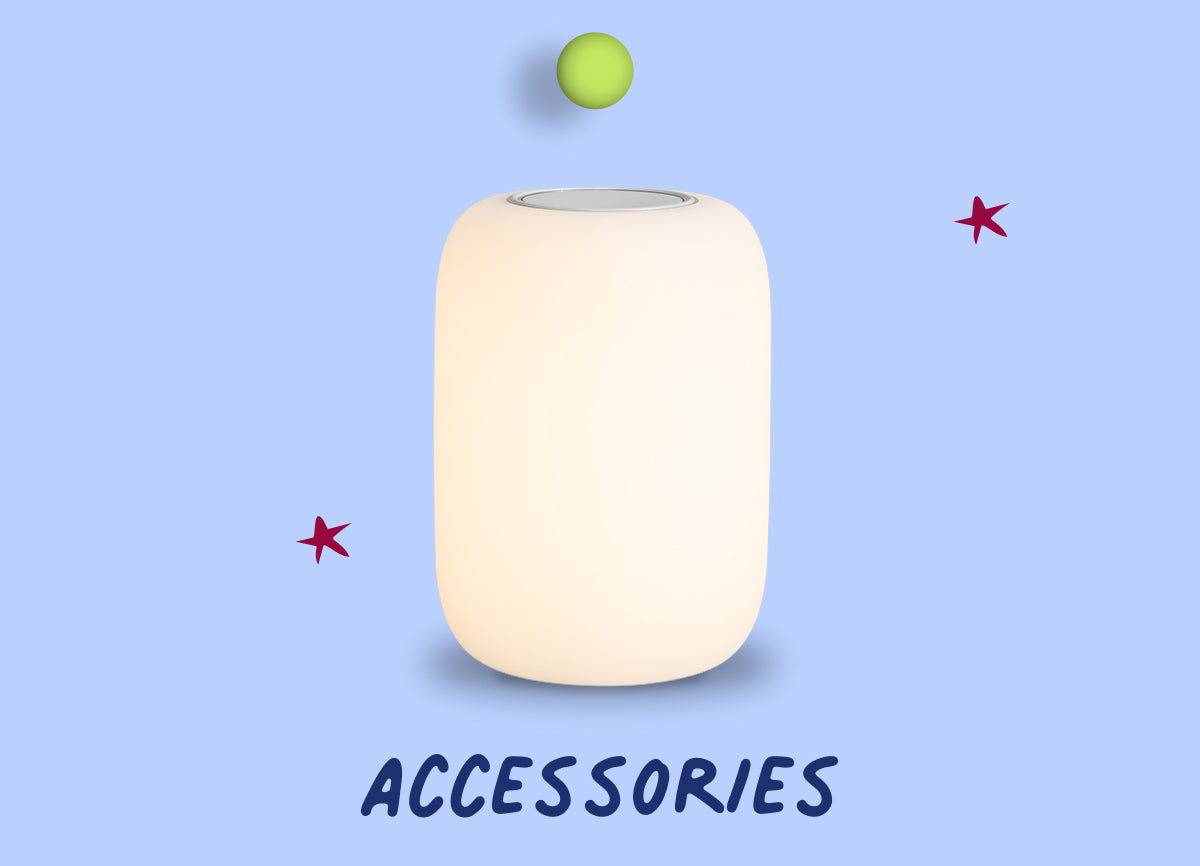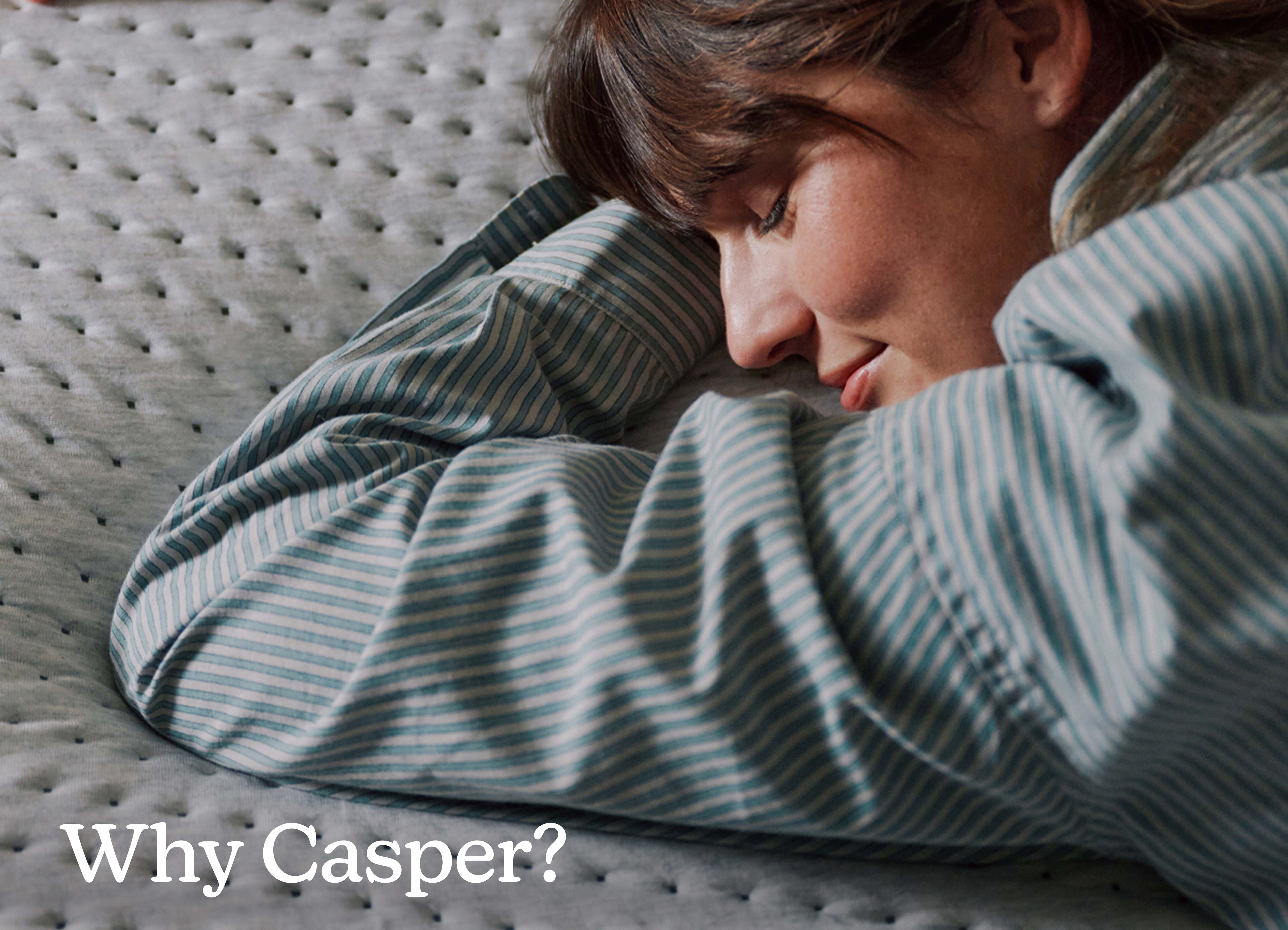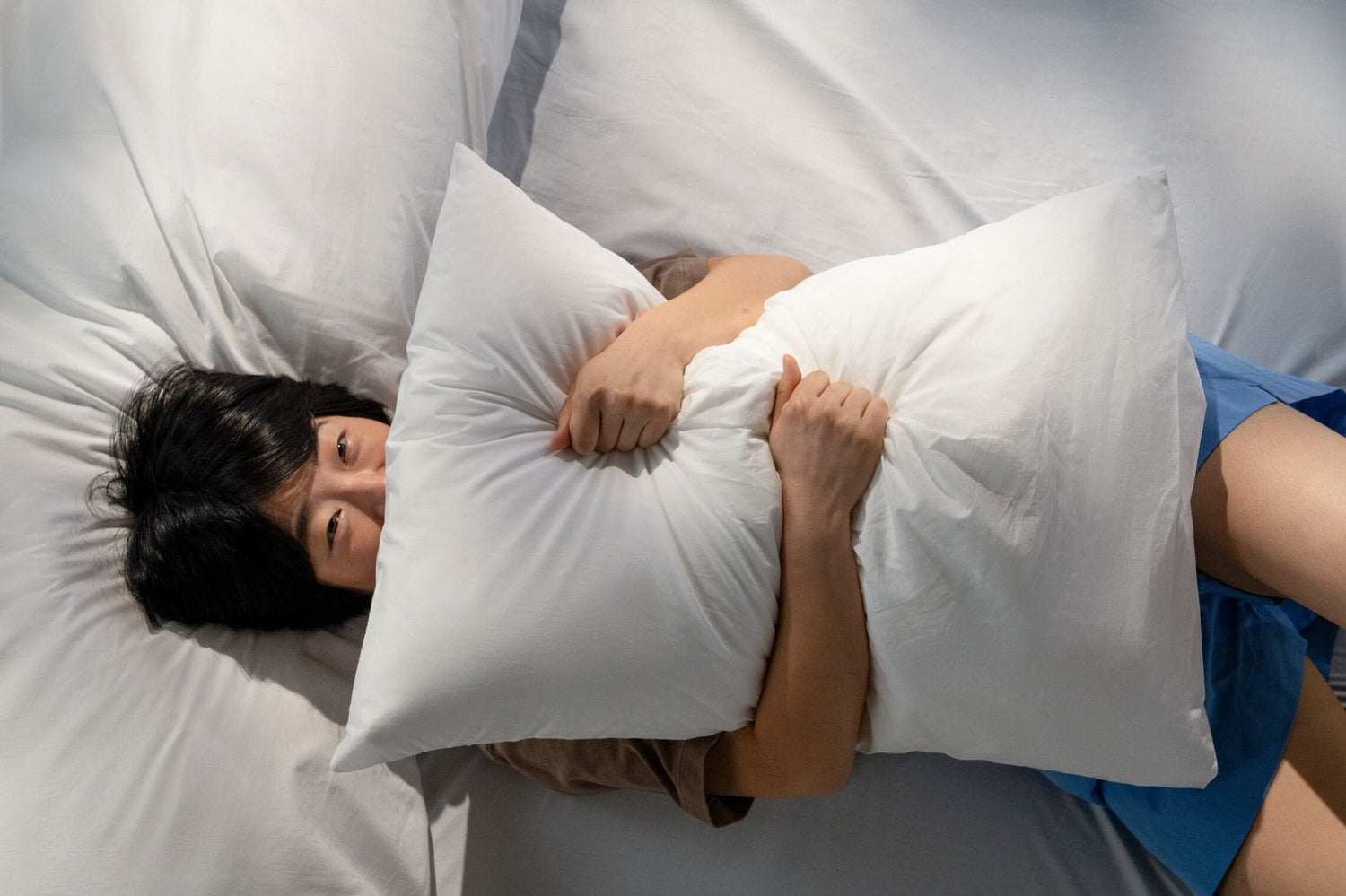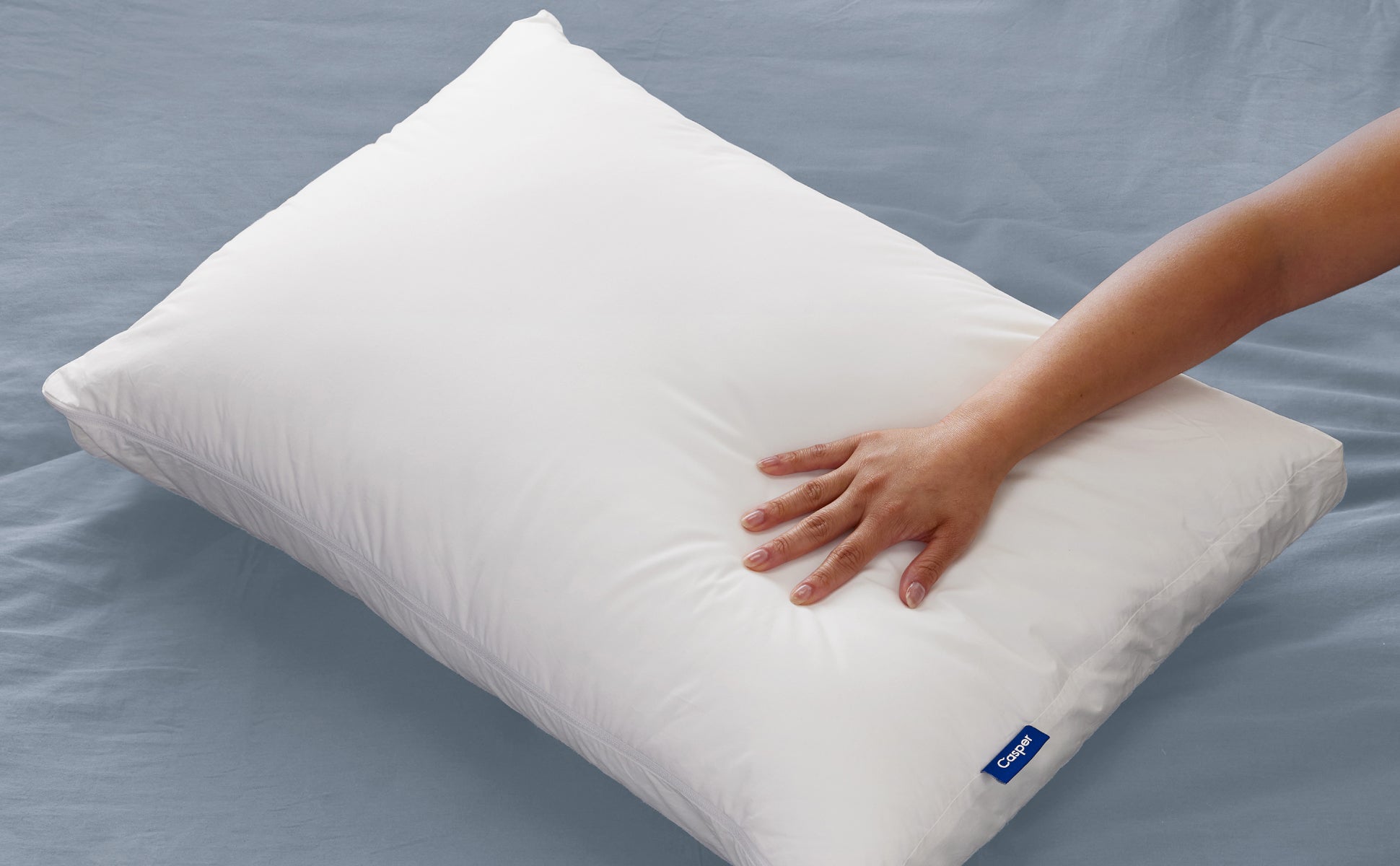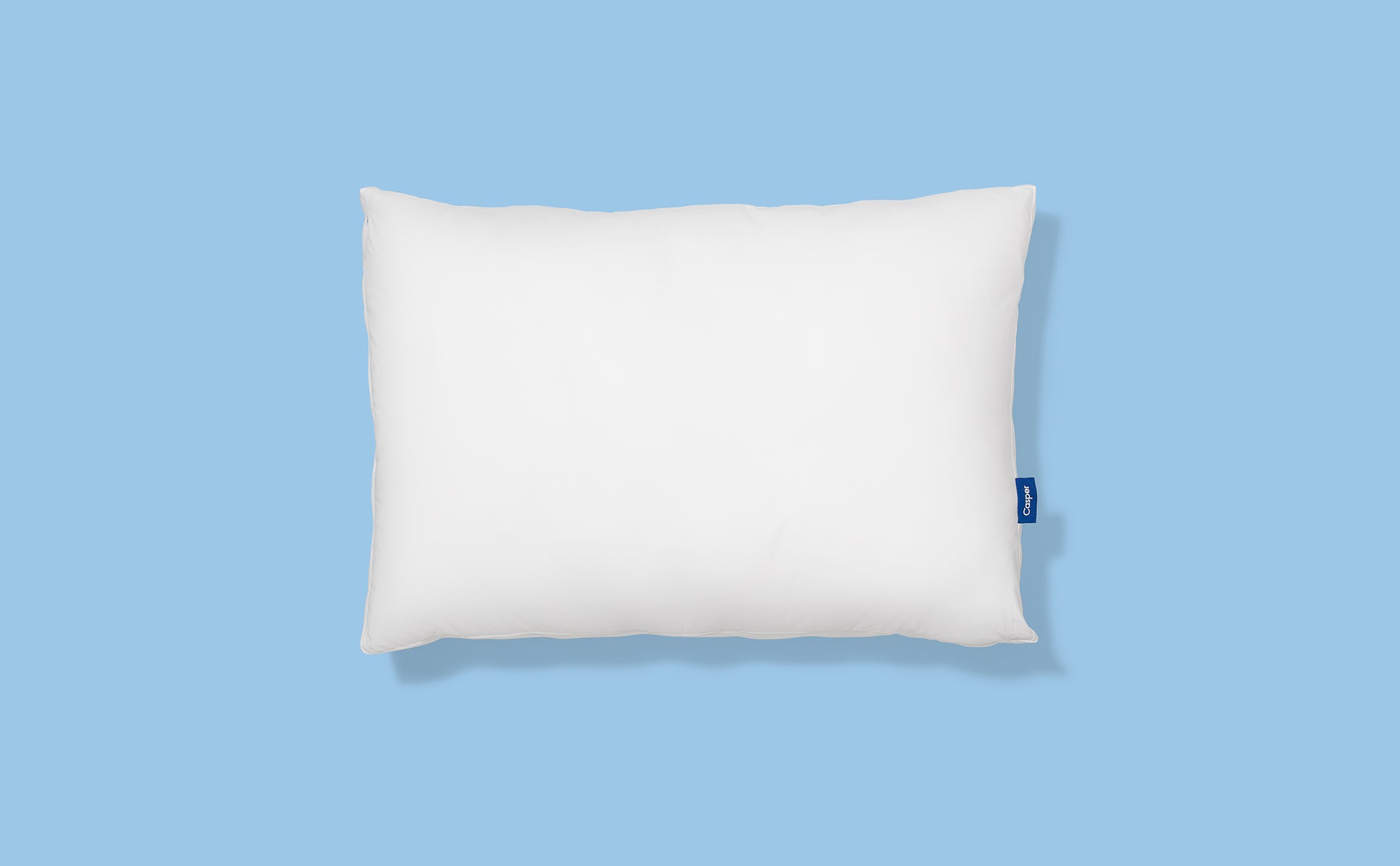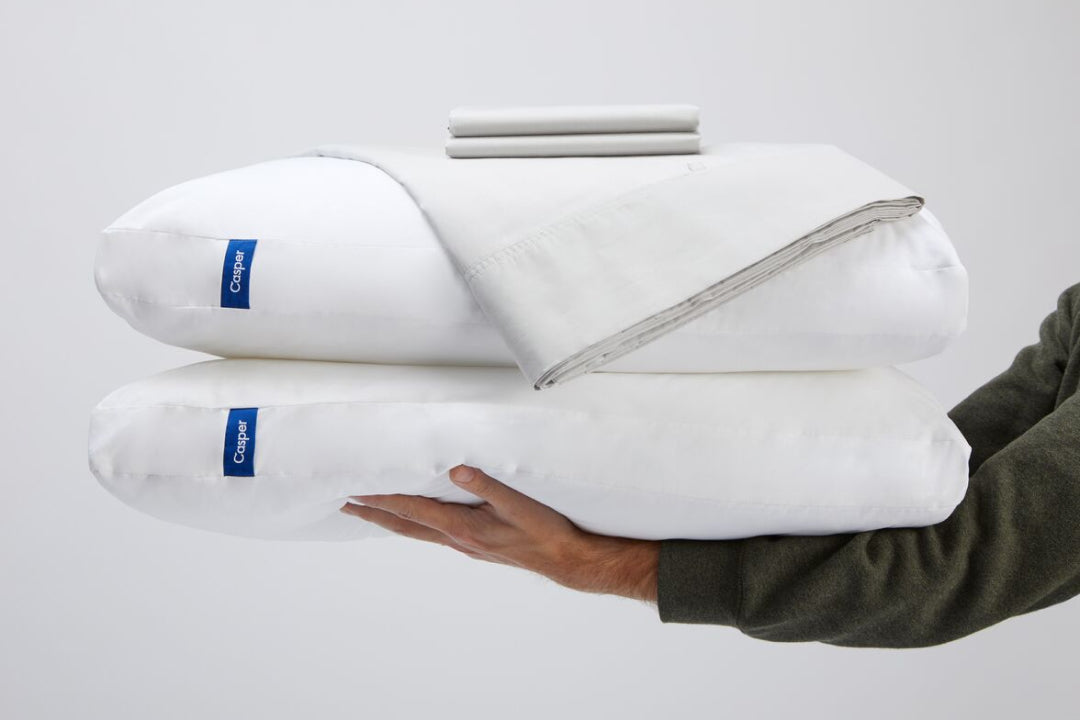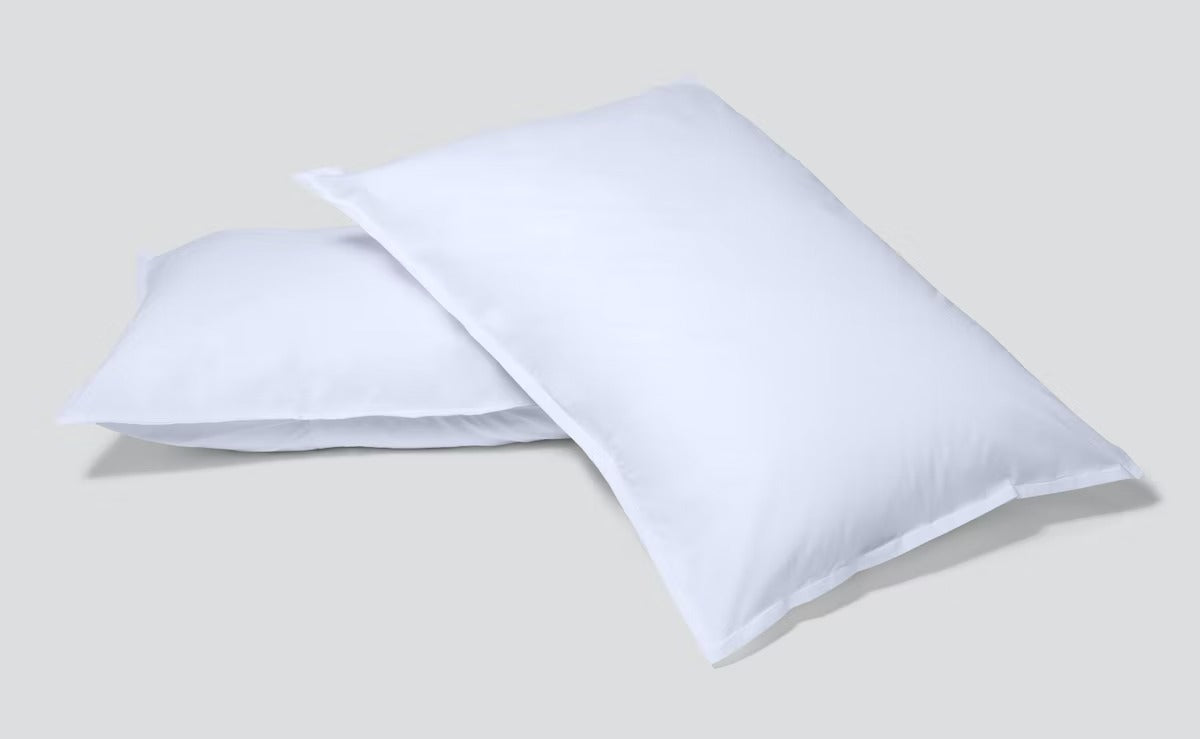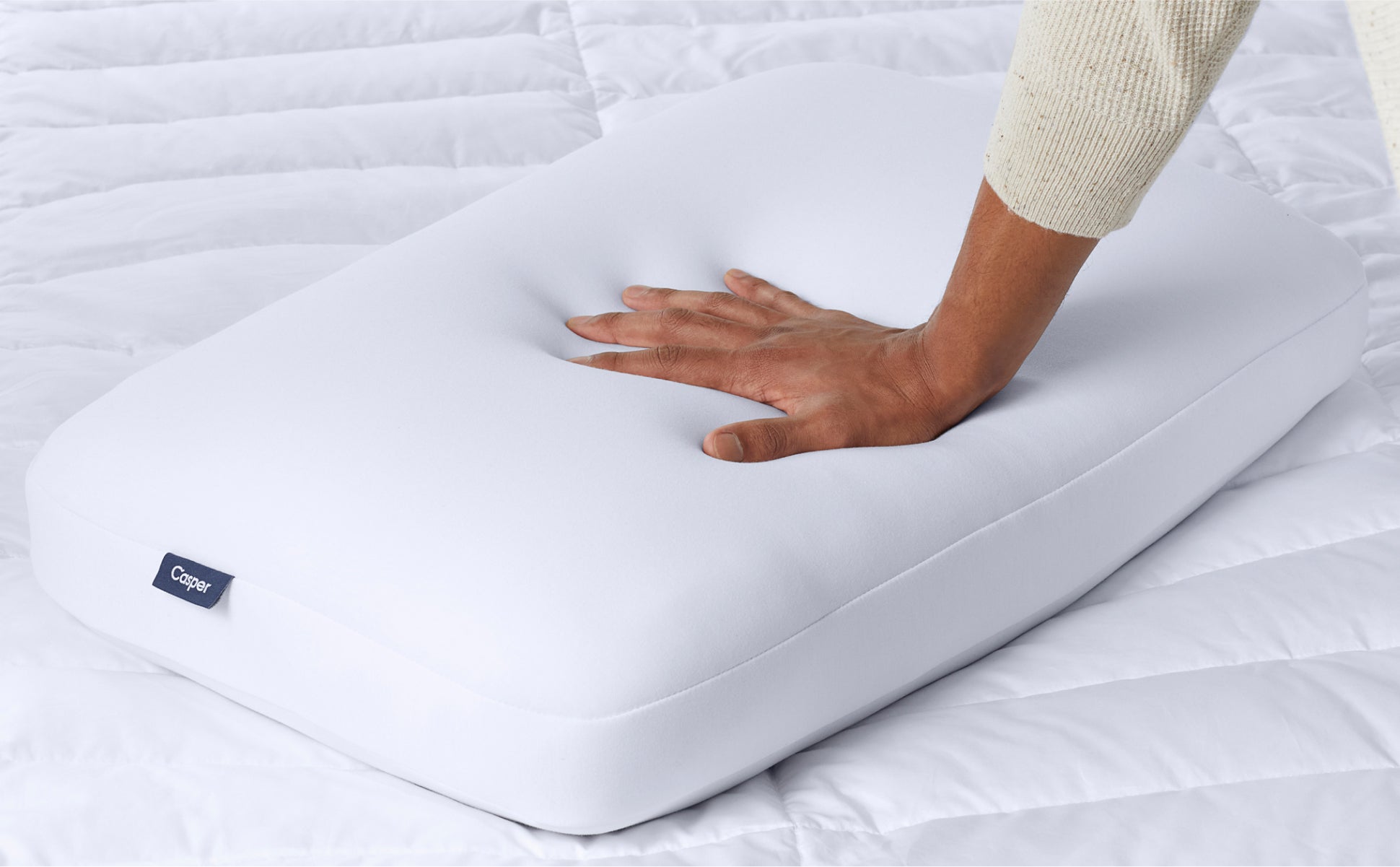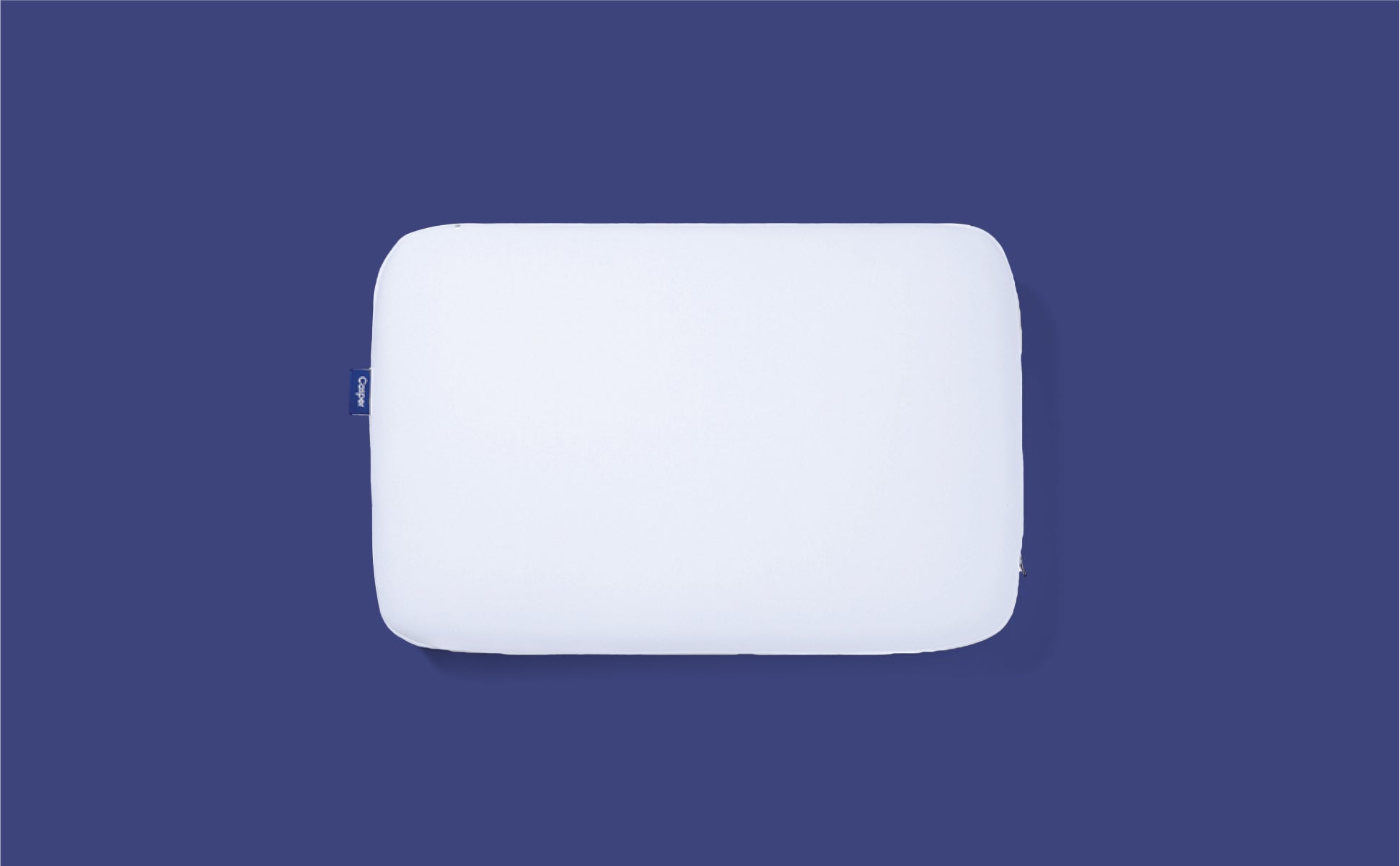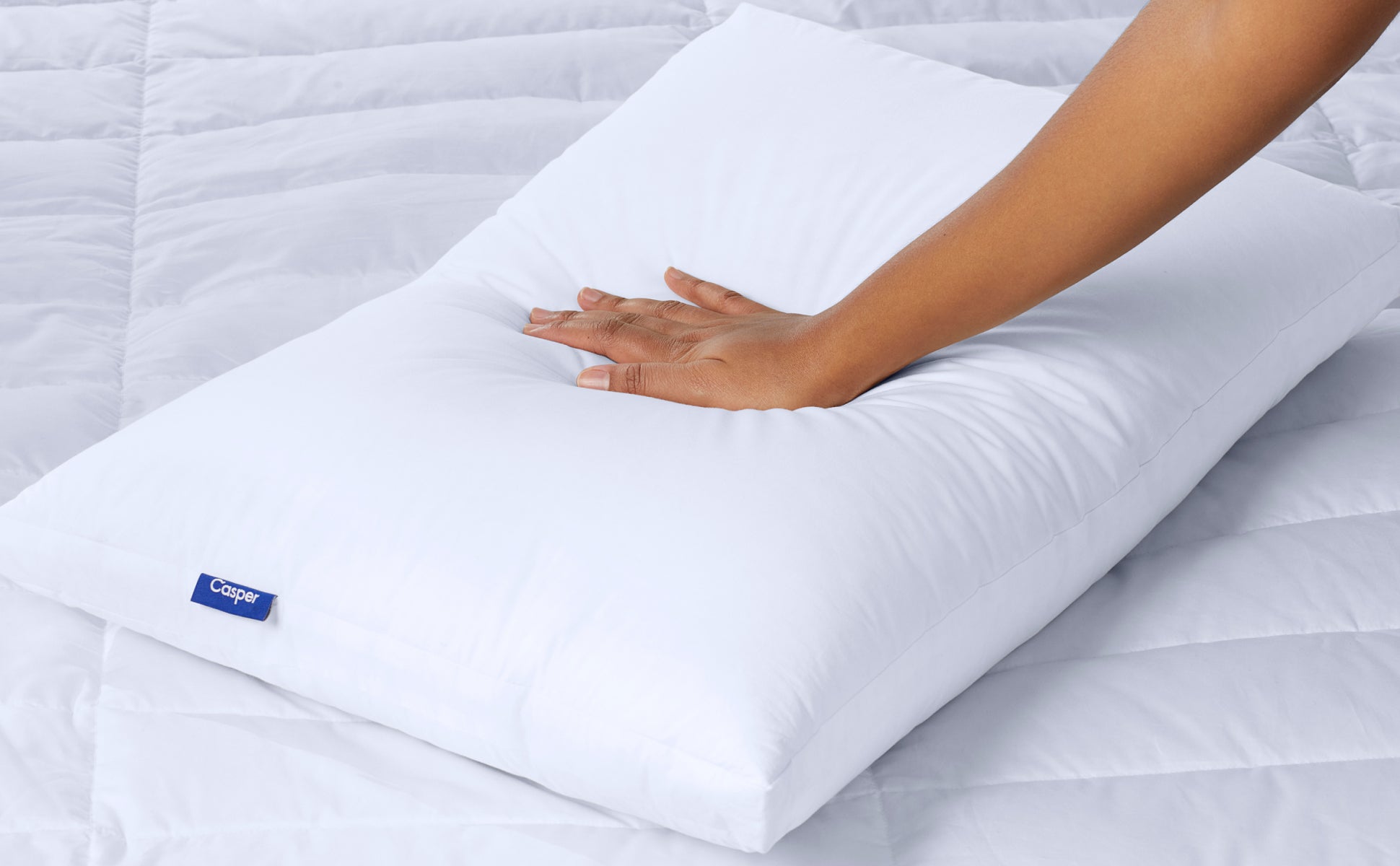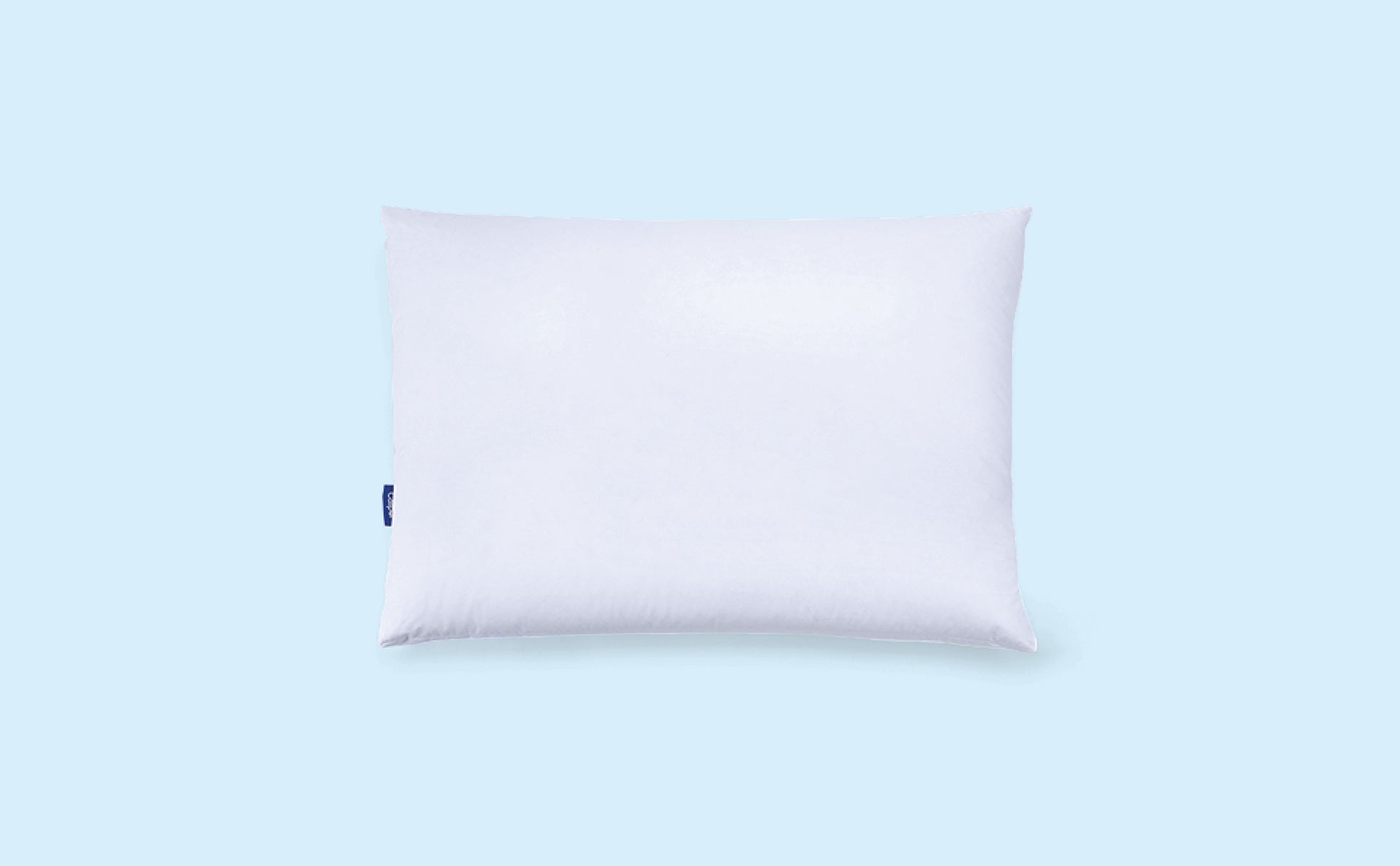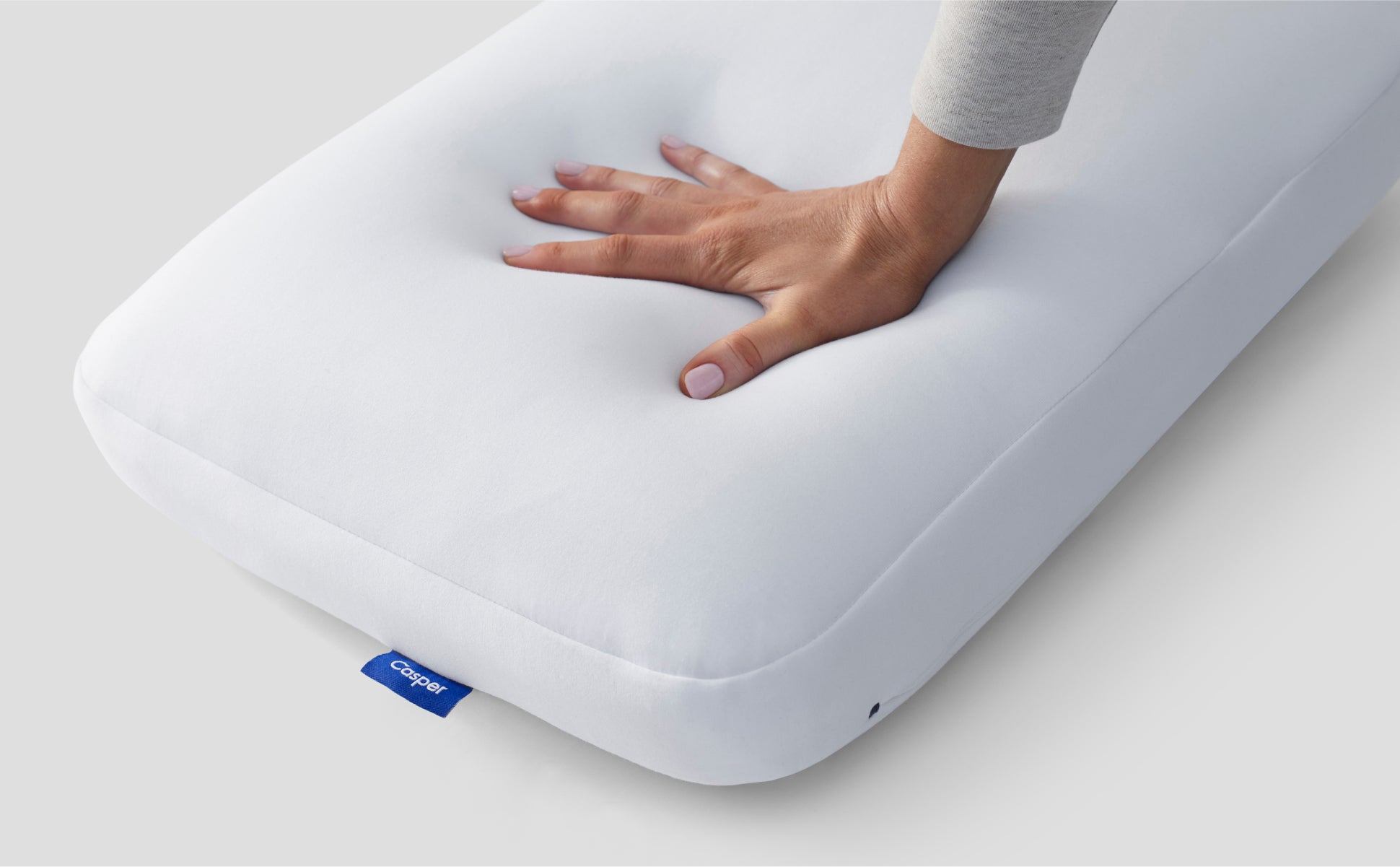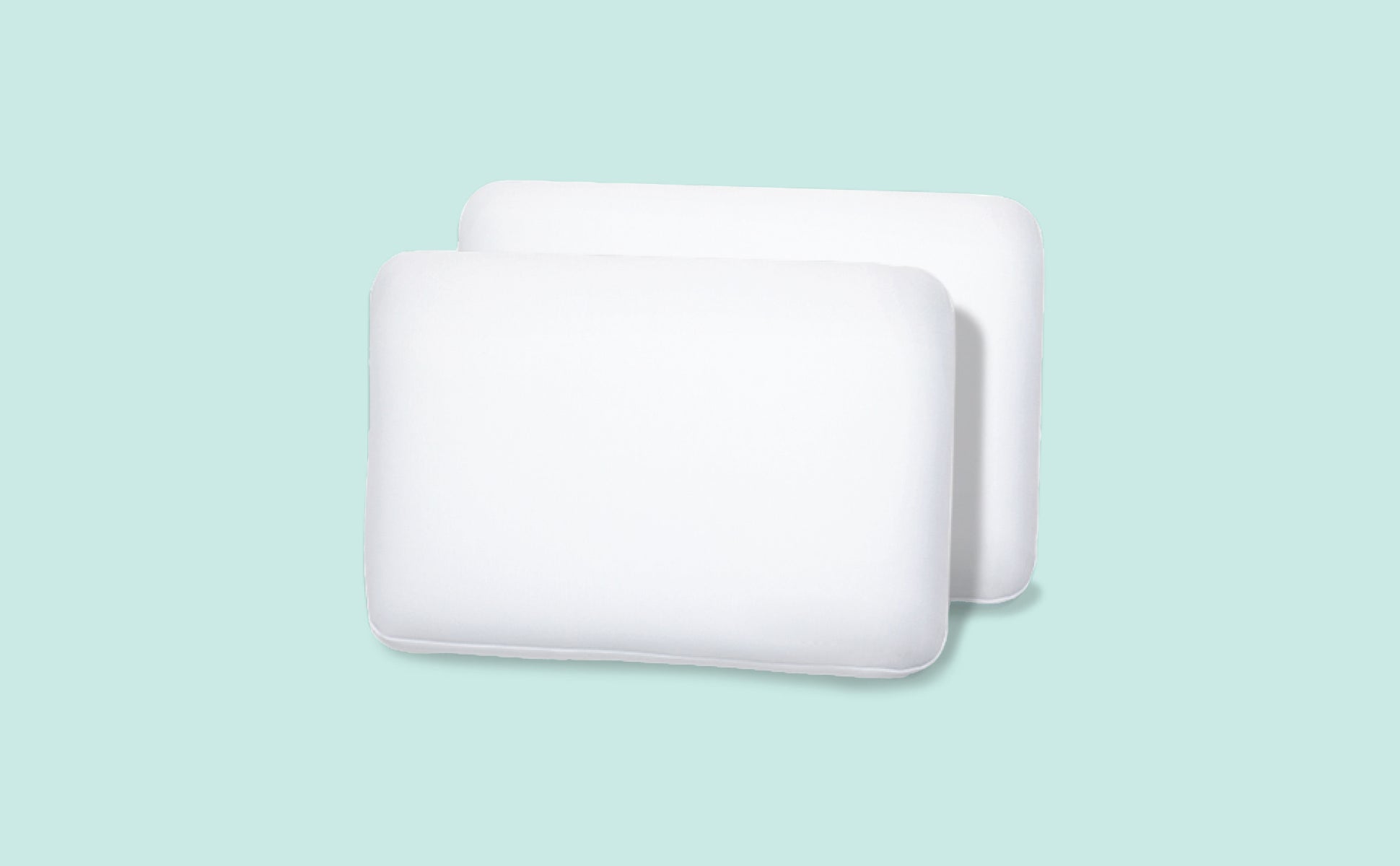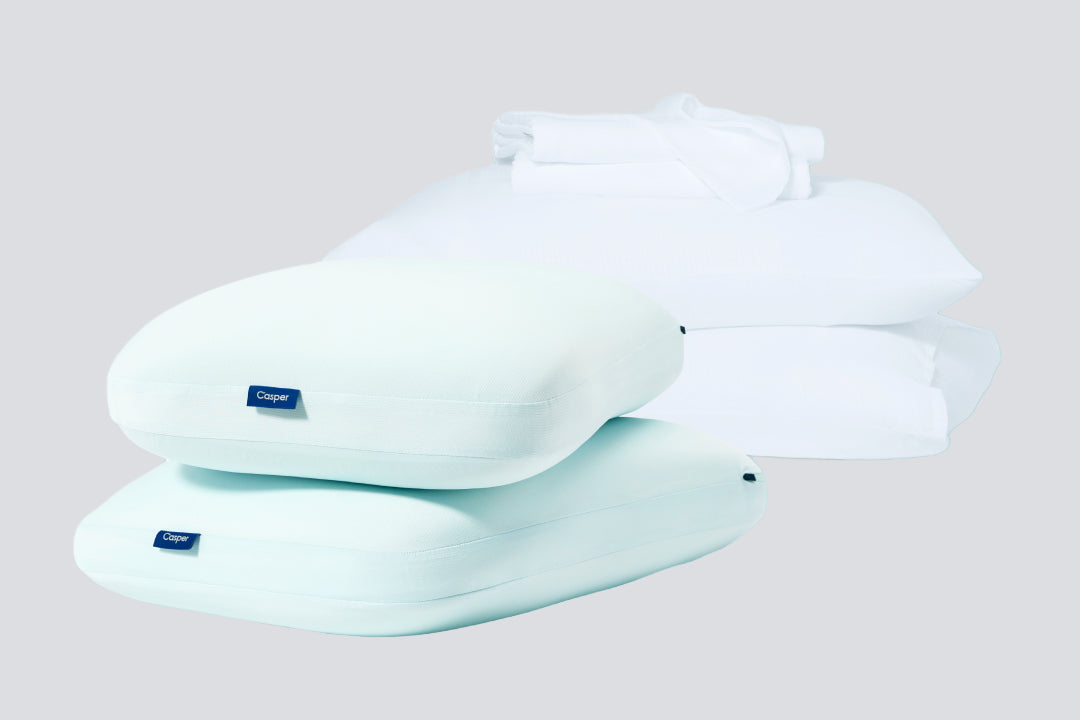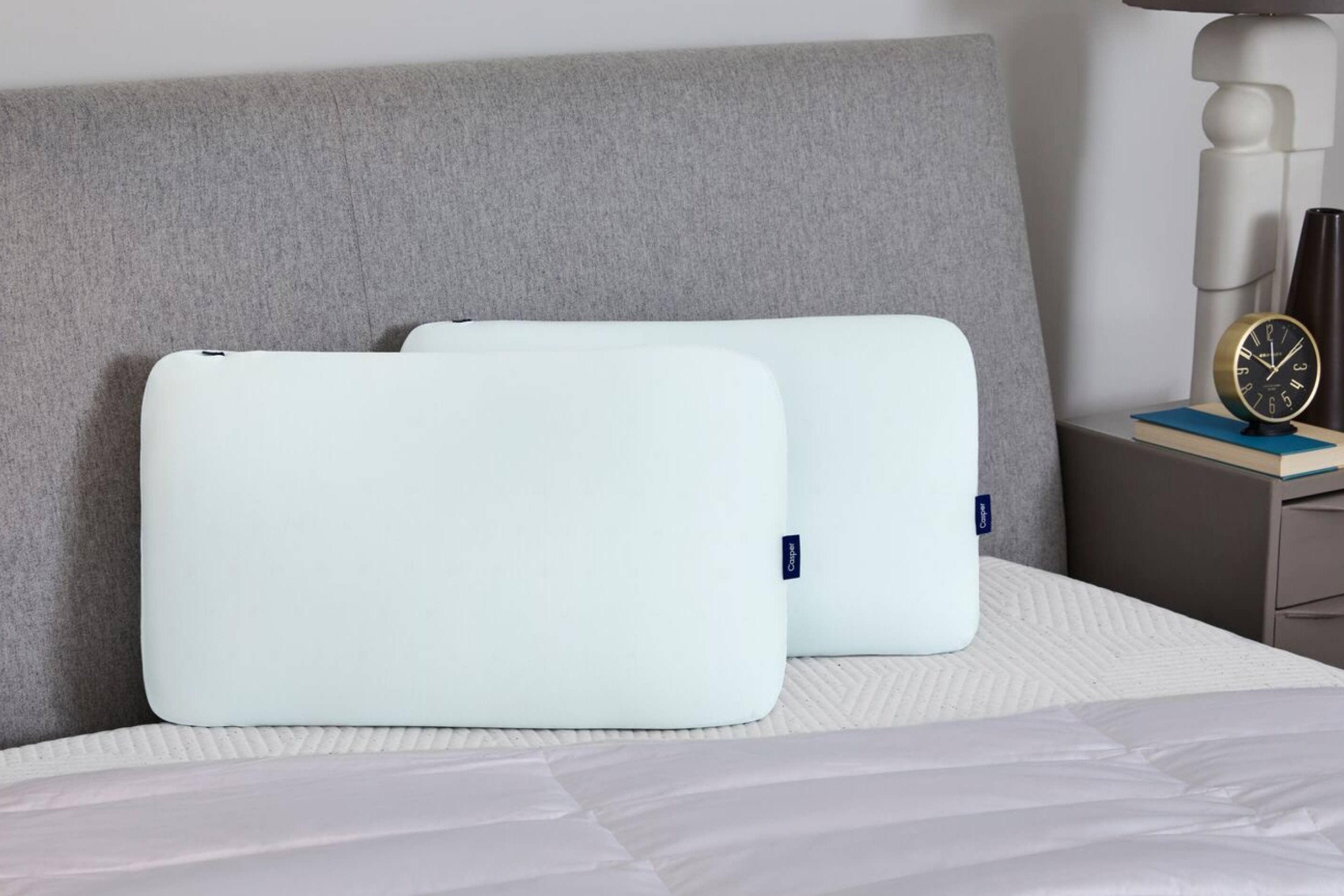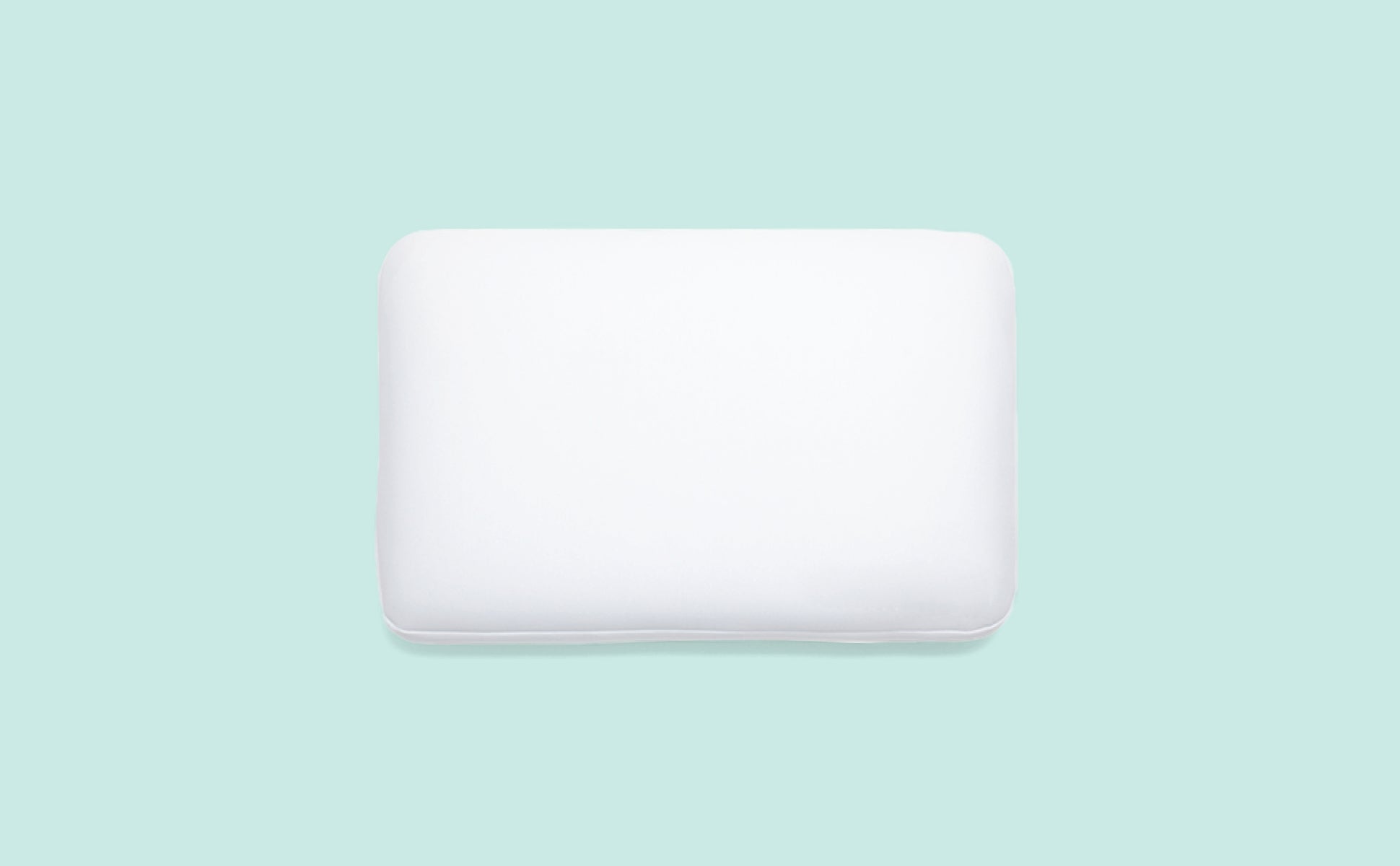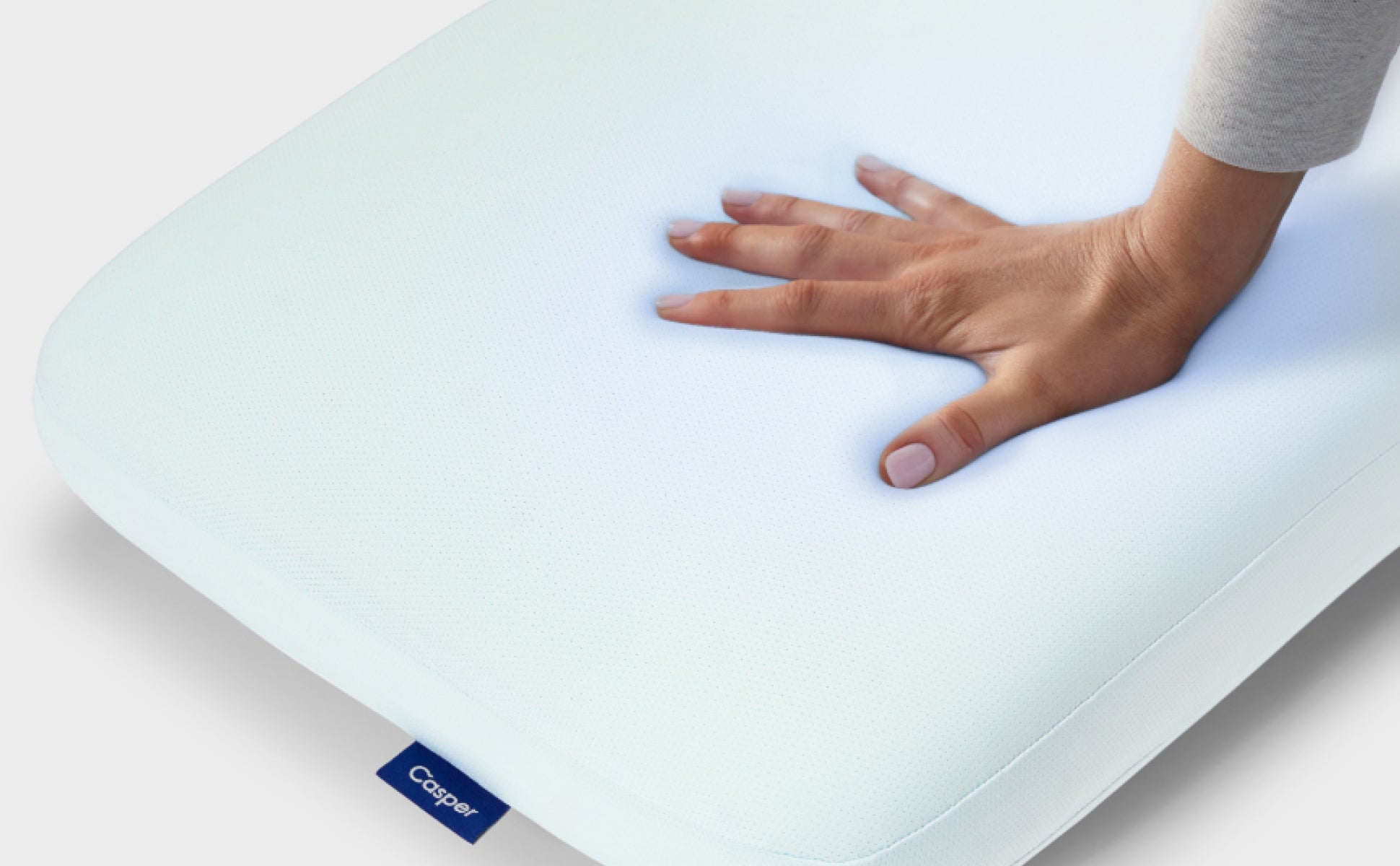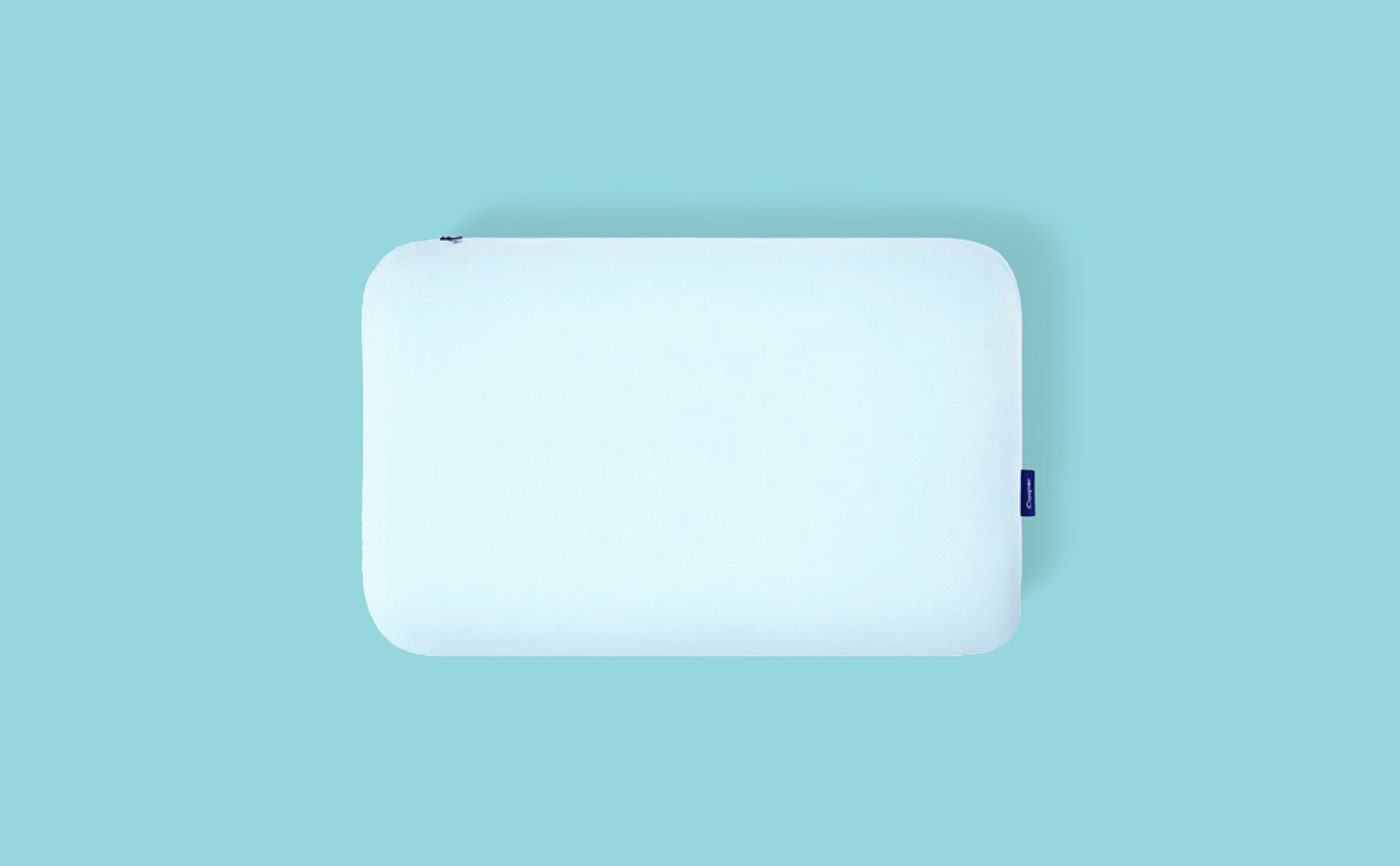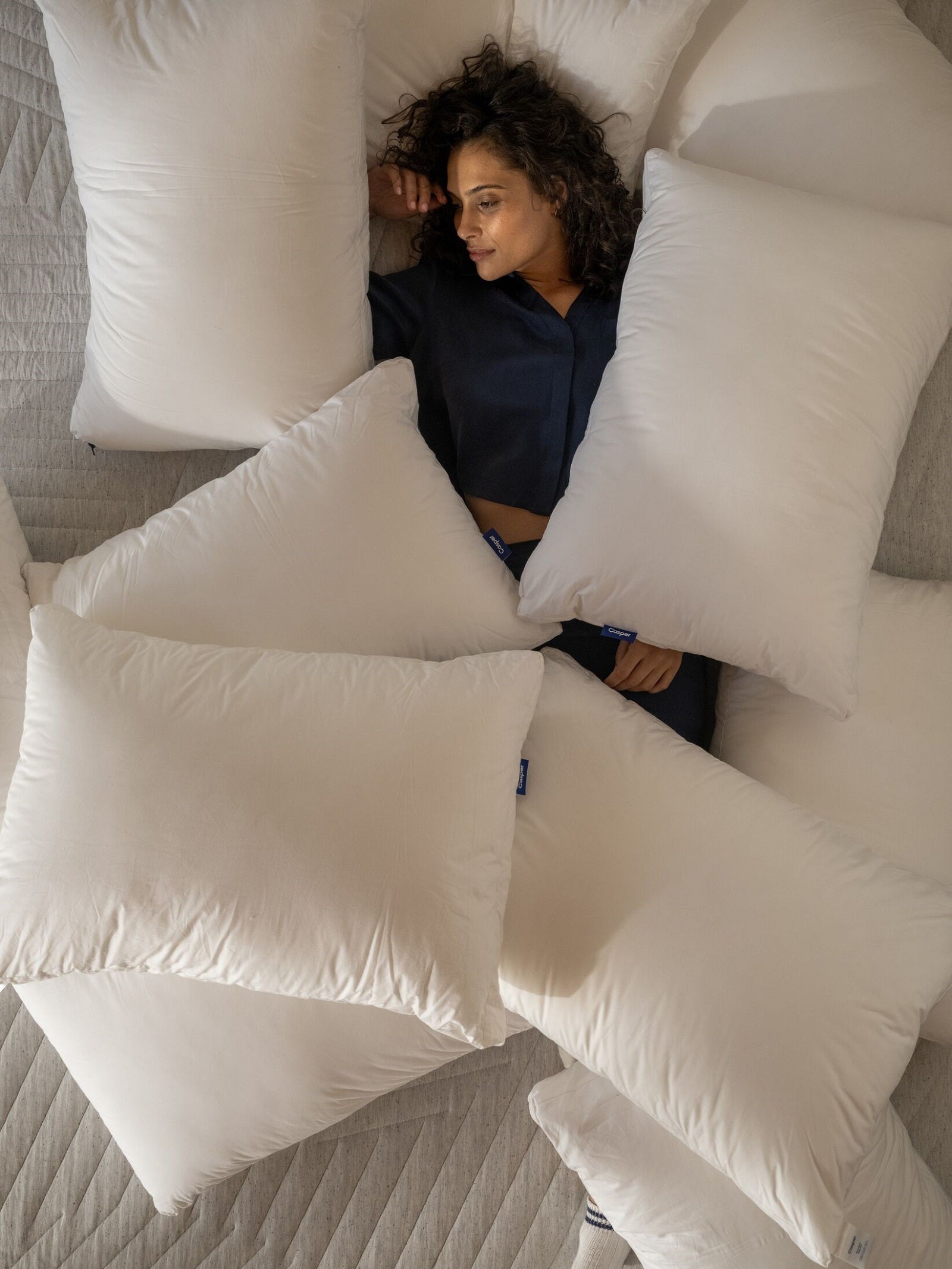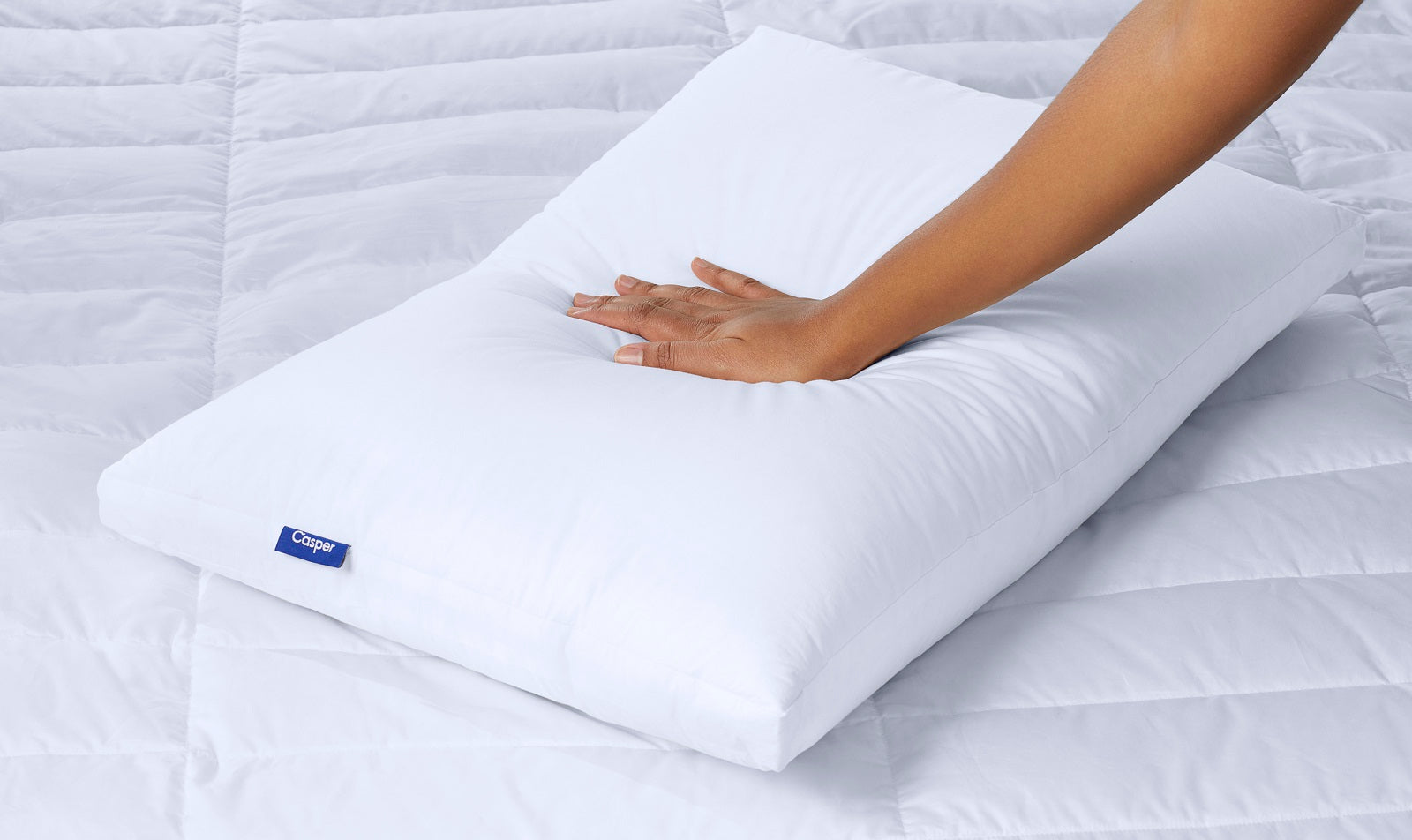Fiber pillows offer soft and fluffy comfort, while foam delivers firm support and contour mapping. To choose between them, consider your personal sleep profile.
When they’re covered in a case, it’s easy to believe all pillows are alike. Under the surface, however, types of pillows vary widely with unique comforts and traits to offer.
One of the most important traits is filling.
Foam pillows come stuffed with filling like memory foam. These pillows offer firm support and mold themselves to the contours of your neck. Fiber pillows, on the other hand, use a fluffy, feathery filling material that’s flexible and easy to clean.
So, between a fiber vs foam pillow, which is right for you?
Let’s put this question to rest.
What is a Fiber Pillow?
Fiber pillows feature a crisp casing that holds heavenly-soft filling. In this case, the filling is made up of synthetic fibers, such as polyester1 and microfiber (a polyester derivative).2
Fiber filling offers some highly desirable traits:
- Softness – It possesses a dreamy, cloudlike consistency.
- Breathability – The fibers, especially microfiber, offer moisture an easy escape route.
- Hypoallergenic – For sensitive sleepers, fiber pillows come in hypoallergenic varieties.
Ultimately, fiber pillows and their cushy interior make for a comfy and highly versatile place to lay your head when the day is done.
What is a Foam Pillow?
While you’re most likely to find memory foam lining the inside of foam pillows, many also feature latex. Both stuffing types offer similar benefits: robust support and elite heat-wicking powers.
When people opt for foam pillows, it’s usually because they adore their:
- Personalized support – Foam conforms itself to the natural contours of your head and neck, providing a tailor-made foundation for sleep.
- Firmness – Although it readily adapts to your body profile, foam also remains unyielding throughout the night. You won’t find yourself sunk into a painful position at 3 am.
- Motion isolation – Foam (especially memory foam) easily absorbs impact. This means movements made during the night stay contained (i.e., they won’t disturb your partner).
While memory and latex foam share much in common, they also differ slightly in their benefits. Latex, for example, leans toward the springy and breathable side of things, while memory foam excels at relieving pressure and soaking up vibrations. Learn more about latex vs memory foam in our blog.
Key Differences Between Fiber and Foam Pillows
So, both filling types offer a snoozy set of benefits. But what makes each one unique? A few factors affect the foam pillow vs fiber pillow debate.
Support and Firmness Levels
When it comes to bedding, some like it soft, and some like it firm—that’s just human nature. When shopping for pillows, consider your unique support needs.
- Fiber – While certainly supportive, fiber filling is best for those looking for a cushy and moldable place to lay their heads. It offers far more flexibility than foam.
- Foam – For those with temperamental necks and backs, foam pillows provide a dependable set of sleep guardrails. Your trunk won’t drift out of alignment during the night, and the foam keeps gravity’s pressure at bay.
In short, support levels play a major role in answering the fiber pillow vs foam pillow question. Learn more about choosing a firm vs soft pillow in our comprehensive blog.
Breathability and Temperature Regulation
As we sleep, our bodies release heat and moisture. It’s up to our bedding, especially our pillows, to keep us cool and dry so that we can remain immersed in a cozy, restorative slumber.
This means your pillow should be breathable. And since they feature distinct materials, foam and fiber pillows “breathe” differently.
In general, fiber pillows (especially microfiber) offer a much smoother path for heat and moisture to escape, making them more breathable.2 For those who sleep hot, breathability is especially important, so fiber pillows make for a better option.
When it comes to foam:
- Memory foam pillows tend to retain moisture
- Latex foam, on the other hand, offers much higher breathability levels
Durability and Lifespan
When you choose a pillow, you want one that will stay with you for the long haul. And when it comes to longevity, foam comes out ahead.
Because of its firm and resilient nature, memory foam can last for years (up to 10 for mattresses).
In comparison, the low-density filling of fiber pillows tends to go flat after 1-2 years.3 The good news is that pillows manufactured with high-quality material, such as the Casper Original, can achieve longer lifespans.
Regular cleaning and fluffing can also boost a pillow’s lifespan.
Maintenance and Cleaning Requirements
Although your bed may feel clean and snug, over time, it acquires a layer of sweat, dust, and dead skin cells. Although a quality pillowcase, such as the Casper Percale Pillowcase Set, shields your pillow from some of this allergy-aggravating gunk, plenty can still find its way through.
Needless to say, this makes regularly washing your pillows a must.
How often should you wash your pillows? Generally, you want to aim for a full cleaning every 3-6 months. This will not only keep them free of contaminants but also help rejuvenate the filling.
Washing Fiber Pillows
Most fiber pillows can go right into the washing machine (although you should always check the care tags first, just in case).
Simply load them up (no more than two at a time), and run them through a gentle cycle using warm water.4 When finished, toss them in the dryer on the lowest setting.
Washing Foam Pillows
Foam pillows, both memory and latex, can’t go into the washing machine. At Casper, we strongly advise against machine washing hybrid or foam pillows or submerging them completely in water. The foam will retain moisture, making it nearly impossible to fully dry out, which can lead to mold growth. However, the cover of your foam or hybrid pillow is washable and should be cleaned regularly. Here’s how:
- Unzip the pillow and remove the cover. Remember, the foam itself is not washable.
- Machine wash the cover on a cold, delicate cycle.
- Lay the cover flat to air dry—skip the dryer to avoid damage.

Choosing the Right Pillow for Your Sleeping Position
Here’s something else to consider: Your foam pillow vs fiber pillow choice may ultimately come down to your sleeping position.
Best Pillow Types for Side Sleepers
Generally, side sleepers need hefty, firm pillows that keep the neck aligned. When it comes to pillow height, they should choose medium (3-5 inches high) to high loft options (5 inches plus) for optimal spine support.
This makes foam pillows a top-tier choice for those who enjoy powering down on their side. Memory foam’s stabilizing power, in particular, serves side sleepers well.
Best Pillow Types for Back Sleepers
Studies show that optimal spine alignment5 stems from sleeping on the back. It also helps prevent shoulder aches and lowers the risk of acid reflux.6
But back sleepers need to ensure that their head is sufficiently elevated. Overly thin or excessively bulky pillows can distort the spine’s shape.
Because this posture is innately healthy, both fiber and foam can be excellent options for back sleeping, so long as they provide proper support. To decide between the two, consider a few of their pros and cons.
The pros of foam pillows for back sleepers include:
- Opens your airway
- Boosts comfort by lifting the head and shoulders
- Preserves your spine’s natural curve7
However, a couple of cons exist:
- Too firm for some
- Can tip the head forward if too high
And how about the pros of fiber pillows for back sleepers?
- Offers malleable filling for customized contours
- Provides consistent support across the pillow surface
Despite the pros, some potential downsides of fiber include:
- May settle or shift during the night causing the neck to flatten
- Might clump up over time and require regular “fluffing”
Regardless of which type of pillow you choose, you can ensure a comfortable night of sleep by investing in a high-quality option, like the Casper Low Loft Memory Foam Pillow or the Casper Hybrid Pillow.
Best Pillow Types for Stomach Sleepers
The rarest sleep type, the stomach sleeper, needs to take extra care with their pillow choice. This is because dozing facedown places extra strain on your back (potentially contributing to neck problems).
So, what’s the ideal pillow for a stomach sleeper? That would be a thin, low loft option with a little extra give in the filling.8 High-loft pillows misalign stomach sleepers’ spines, while ultra-firm filling can irritate the face (which, for stomach sleepers, presses into the pillow).
This makes options like The Casper Low Loft Memory Foam Pillow ideal for those who savor a snooze in the freefall position.

Special Considerations When Choosing Between Fiber and Foam
While sleep posture plays the biggest role in the pillow selection process, there are a few finer points you’ll want to take into account before snuggling up to a fresh pillow.
Sensitivities and Allergies
If you’re prone to allergies, consider fiber pillows. Some filling types, like down, attract dust and serve as an inviting environment for dust mites. These microscopic critters can trigger9:
- Red eyes
- Sore throat
- Coughing and breathing troubles
Synthetic fills, such as down alternative and fiber options, help keep allergies at bay10 (leaving you free to drift off to dreamland).
While generally hypoallergenic, some people may still experience allergic reactions to memory foam and latex. Symptoms can include skin rashes, respiratory issues, and dizziness.11
These materials may also release small amounts of vapor, especially when new. We call this “off-gassing.”12 Although harmless, sensitive individuals may struggle with the smell.
Budget and Long-Term Value
Price is always a factor when choosing your bedding. So, how does cost impact the fiber vs foam pillow debate?
Generally, memory foam tends to sit at the more costly end of the spectrum. But because memory foam lasts up to a decade, its extended service life can counteract the upfront investment (not to mention the impact it could have on your sleep health).
Fiber pillows clock in at more affordable rates, but their limited lifespan means you’ll have to replace them more often.
Sustainability and Environmental Impact
With regard to pillows, memory foam carries a heavier ecological impact. This is because memory foam consists of chemicals like polyurethane which take an exceedingly long time to break down.
Polyester fiber, commonly found inside fiber pillows, is generally recyclable.12 So, fiber comes out ahead in eco-friendliness.
Finding the Right Casper Pillow for Your Needs
Whether you feel drawn to the springy world of fiber pillows or memory foam’s cranium cradling support, at Casper, we have you covered. From our cooling Foam Pillow with Snow Technology (which ices down memory foam’s penchant for heat-trapping) to the fluffed-out fiber vibes of the Original Casper Pillow, we offer a wide variety of pillow options that’ll have you setting sail for dreamland in no time.
Discover the bliss that lies beyond deciding on a pillow. Discover Casper today.
Sources:
- VNPOLYFIBER. Product Detail: Silicon Fiber, Pillow Fiber, Toy Filling Material, White Color Fiber. https://vnpolyfiber.com/product/silicon-fiber-pillow-fiber-toy-filling-material-white-color-fiber/
- Colossus Tex. Microfiber Vs Polyester. https://colossustex.com/microfiber-vs-polyester/
- NY Mag. When Should Your Replace Your Pillows? https://nymag.com/strategist/article/when-to-replace-pillows.html
- MarthaStewart.com. How to Wash Pillows the Right Way. https://www.marthastewart.com/2221370/how-wash-pillows
- National Library of Medicine. Identifying relationships between sleep posture and non-specific spinal symptoms in adults: A scoping review. https://pmc.ncbi.nlm.nih.gov/articles/PMC6609073/
- National Library of Medicine. Effect of bed head elevation during sleep in symptomatic patients of nocturnal gastroesophageal reflux. https://pubmed.ncbi.nlm.nih.gov/22098332/
- WebMD. Memory Foam Pillows: What You Need to Know.https://www.webmd.com/sleep-disorders/memory-foam-pillows-what-to-know
- Forbes. How To Choose A Pillow That Perfectly Suits Your Sleep Needs https://www.forbes.com/sites/forbes-personal-shopper/article/how-to-choose-pillow/
- WebMD. Dust Mite Mattress and Pillow Covers for Allergies. https://www.webmd.com/allergies/dust-mite-mattress-and-pillow-covers-for-allergy-relief
- Healthline. The 7 Best Hypoallergenic Pillows. https://www.healthline.com/health/best-hypoallergenic-pillows#what-is-hypoallergenic
- Wyndly. Preventing Memory Foam Mattress Allergies: Symptoms and Solutions. https://www.wyndly.com/blogs/learn/memory-foam-allergy?srsltid=AfmBOoprtM6DfAQOZ6s7bWnyMVqZQdHkVlPAchCfbOZLplVwXugm-wMJ
- My Non-Toxic Tribe. My Non-Toxic Tribe: Guide To Choosing A Safe, Non-Toxic Pillow. https://mynontoxictribe.com.au/non-toxic-pillow-guide/
- FC Dry Cleaners. The Best Fabrics for Hot Weather: Breathable Fabric for Summer. https://fcdrycleaners.com/blog/the-best-fabrics-for-hot-weather/
- Elle. 12 Of The Best And Worst Fabrics To Wear In Summer Heatwaves If You Want To Avoid Sweat Patches.https://www.elle.com/uk/fashion/what-to-wear/a22069616/best-worst-fabrics-summer-sweat/

